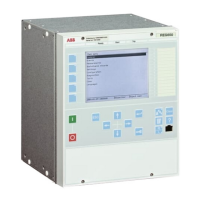Table 2: Test points for phase-to-phase
Test
points
X R
P1 ZxFwd · sin(ImpedanceAng) ZxFwd · cos(ImpedanceAng)
P2 (ZxFwd-ZxRev)/2 · sin(ImpedanceAng) ZxFwd/2 · (1+cos(ImpedanceAng)+ ZxRev/2 · (1-
cos(ImpedanceAng)
P3 (ZxFwd-ZxRev)/2 · sin(ImpedanceAng) -ZxFwd/2 · (1-cos(ImpedanceAng) -ZxRev/2 ·
(1+cos(ImpedanceAng)
P4 -ZxRev · sin(ImpedanceAng) -ZxRev · cos(ImpedanceAng)
Change the magnitude and angle of phase-to-phase voltage to achieve impedances at
test points p1, p2 and p3. For each test point, observe that the output signals, START
and STZx are activated where x refers to the actual phase to be tested. After the timer
tZx (where x is 1-3 depending on selected zone) for the actual zone has elapsed, also
the signals TRIP and TRZx (where x is 1-3 depending on selected zone) shall be
activated.
6.4.3 Loss of excitation LEXPDIS
Prepare the IED for verification of settings as outlined in
5.1 "Preparing the IED to
verify settings".
Values of the logical signals for LEXPDIS are available on the local HMI under Main
menu/Tests/Function status/Impedance/LEXPDIS(40)/LEXPDIS:1. The Signal
Monitoring in PCM600 shows the same signals that are available on the local HMI.
6.4.3.1 Verifying the settings
The test is done by means of injection of three phase current and three phase voltage
from a modern test device. This test device shall be able to give voltage and current
corresponding to the set apparent impedance.
1. Feed the IED with current and voltage corresponding to the apparent impedance:
Test #1, as shown in figure
12. Read the analog outputs for R and X and check
that this reading corresponds to the injected impedance. No start or trip signals
shall be activated.
2. Feed the IED with current and voltage corresponding to the apparent impedance:
Test #2, as shown in figure 12. Read the analog outputs for R and X and check
that this reading corresponds to the injected impedance. No start or trip signals
shall be activated.
3. Feed the IED with current and voltage corresponding to the apparent impedance:
Test #3, as shown in figure
12. Read the analog outputs for R and X and check
that this reading corresponds to the injected impedance. The signals START and
STZ2 shall be activated instantaneously and the signals TRIP and TRZ2 shall be
activated after the set delay tZ2.
1MRK 502 049-UEN A Section 6
Testing functionality
53
Commissioning manual

